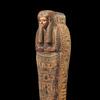The Rich, Cultural Diversity of American Folk Art in the Abby Aldrich Rockefeller Folk Art Museum's Collection to be Seen in New Exhibition Opening in July 2017 in Honor of the Museum's 60th Anniversary
- WILLIAMSBURG, Virginia
- /
- May 22, 2017

Some pieces are pure whimsy, others are completely useful. One thing is certain: All of the objects to be featured in America’s Folk Art, celebrating the 60th anniversary of the Abby Aldrich Rockefeller Folk Art Museum (AARFAM), one of the Art Museums of Colonial Williamsburg, highlight an art form as culturally rich and diverse as America itself. Through approximately 50 objects that include furniture, sculpture and paintings made between the 1700s and the present, the country’s oldest, continuously operating institution solely dedicated to the collection, exhibition and preservation of American folk art will showcase why this art form (historically aimed chiefly at the middle class) is enjoying a popularity resurgence. The exhibition, which will open on July 1, 2017, will remain on view through December 2019.

“Abby Aldrich Rockefeller was a visionary collector, recognizing the merits of everything from contemporary art to traditional folk art as early as the 1920s. It is entirely fitting that we celebrate her contributions to the American art world in this, the sixtieth anniversary of the museum named in her honor,” said Ronald L. Hurst, Colonial Williamsburg’s Carlisle H. Humelsine chief curator and vice president for collections, conservation, and museums.
In its narrowest interpretation, folk art encompasses tradition-bound painting and drawings, sculpture and decorative arts produced by geographically or culturally-isolated groups. The AARFAM, however, defines its collection of American folk art as objects made from the 1700s through today by amateur or professional artists and tradesmen for their own pleasure or needs or for sale to the common person. Folk art may show an awareness of academic art conventions, illustrate the tastes of popular culture or indicate conservative folk roots. America’s Folk Art will illustrate objects created across the country from the Northeast to Oregon, the South to Mid-West and date from the 18th through the 21st centuries. The exhibition will offer case studies of a variety of works of art on the themes of inspirations, recycled materials, whimsy and popular art. Another section will pay tribute to Abby Aldrich Rockefeller through a video and display of some of her original pieces; it was 250 objects from her collection that became the founding core of what has become the AARFAM.
“From its inception, the Abby Aldrich Rockefeller collection represented some of the finest examples of American folk art,” said Laura Pass Barry, Juli Granger curator of paintings, drawings and sculpture. “This exhibition celebrates our founder’s vision and the sustained growth of the museum collection over the past six decades through a visually rich and dynamic display of material.”

Among the many star pieces in America’s Folk Art is The Preacher, a carving made of butternut and white pine made (probably) in Indiana, ca. 1870, by an unnamed artist. Mrs. Rockefeller purchased it from the famed art dealer Edith Gregor Halpert in the early 1930s. At the time Mrs. Halpert acquired the piece, it was believed to be a portrait of the charismatic 19th-century Congregationalist clergyman Henry Ward Beecher. It has since been identified as a stylized version of a famous 19th-century German statue of the 16th-century theologian Martin Luther. The statue was so popular that soon after it was erected in 1868, small metal replicas were made as souvenirs, one of which likely served as inspiration for this carving. The artist has created here a piece that concisely conveys the compelling image of a man in communion with his maker. Another of Mrs. Rockefeller’s objects given to Colonial Williamsburg to be on view in America’s Folk Art is the Liberty Enlightening the World weathervane, a copper-and-zinc alloy piece probably made in New York between 1900 and 1910. At the time, in order to remain competitive and to encourage new business, weathervane manufacturers periodically introduced fresh, current designs. In this case, the Statue of Liberty, which then was a fairly recent addition to the New York skyline and, when dedicated in 1886 had created an outpouring of national pride, was the inspiration for this weathervane. Undeterred by the fact that the figure had insufficient horizontal elements to be turned effectively by the wind, weathervane makers counteracted the deficiency by mounting the lady on an arrow having a weighted point and broad feathers. Although several companies probably made similar vanes, only two are known to have illustrated the design in their catalogues: the J.L. Mott Iron Works of New York City and Chicago and J.W. Fisk of New York City.
A featured painting in the exhibition is Wallowa Lake, an oil on canvas by Stephen W. Harley (1863-1947), painted in Oregon between 1927-1928. Harley, who was born and raised on a Michigan farm, found his artistic expression late in life in the magnificent scenery of the Pacific Northwest. He never married and remained on the Mid-Western farm through both his parents’ lifetimes. After their deaths, Harley became increasingly restless and hostile to the confining lifestyle represented by farm life. In the mid 1920s, he set off to visit relatives in California and to explore the Pacific Northwest. The landscape there enthralled him, and he made it the subject of four of his five known oil paintings, all of which are in the AARFAM collection along with his sketchbook and photographs. Across the county in Pennsylvania’s rural Schwaben Creek Valley, an area settled by Germans from Southeastern Pennsylvania and by German immigrants, a distinctive style of decoration was used by a handful of local craftsmen during the 1830s and ‘40s: six-petal, stamped red and yellow flowers and the use of symmetrical birds flanking the central flowers. In a chest of drawers made in 1831 of tulip poplar, yellow and white pine and paint to be shown in America’s Folk Art, the flowers framing the case and birds on the drawer fronts show the characteristic style of the region. On the lowest drawer are depictions of praying children, probably copied from very similar examples on printed Pennsylvania German fraktur (illustrated birth, baptismal and marriage certificates) of the period.
Of the more decorative objects in America’s Folk Art is a Fireman’s Parade Hat, made ca. 1850 in Philadelphia of pressed felt with paint and gilding. In the 18th and 19th centuries, volunteer firemen often named their companies after heroic figures. The Decatur Fire Company of the Frankford District of Philadelphia so honored Stephen Decatur, a young naval lieutenant whose daring exploits in the Tripolitan War (1801-1805) caught the public’s imagination. Show hats like this one were worn when companies turned out for parades and musters, both of these being festive occasions on which companies vied for the approval of the crowd by displaying spiffy, colorful attire and immaculate, well-maintained equipment. A whimsical example of folk art in the exhibition is Vollis Simpson’s Ice Cream Scoop Sculpture, made in 1995 in Lucama, North Carolina. This colorful confection, which moves with the wind, is studded with ice cream scoops and metal stars cut from cast-off, reflective highway signs. Simpson (1919-2013), whose work became the official folk art of North Carolina after his death, was born into a farming family. Before World War II, he moved houses as a business and after the war, he and friends opened a machinery repair shop. Between the two jobs, he collected myriad metal, industrial and transportation scraps that eventually became the basis for marvelous sculptures and whirligigs. It wasn’t until after he retired at age 65, that he began to create wonderful pieces that soon took over the and around his house; wind-driven pieces of all shapes, materials and color attracted the attention of passers-by. This piece is one of his smaller creations.
America’s Folk Art is generously funded by Don and Elaine Bogus.
The ideal introduction to the art form for novices, America’s Folk Art will also offer a superb assemblage that aficionados will appreciate. Visitors of all ages will delight in the colorful works selected for view. For those folk art lovers who missed seeing the acclaimed exhibition Abby Aldrich Rockefeller Folk Art Museum: Evolution and Revolution at New York’s Winter Antiques Show in January, America’s Folk Art will also include several of the popular objects featured in that show.
About the Art Museums of Colonial Williamsburg
The Art Museums of Colonial Williamsburg include the Abby Aldrich Rockefeller Folk Art Museum and the DeWitt Wallace Decorative Arts Museum. The Abby Aldrich Rockefeller Folk Art Museum is home to the nation’s premier collection of American folk art, with more than 7,000 folk art objects made during the 18th, 19th and 20th centuries. The DeWitt Wallace Decorative Arts Museum exhibits the best in British and American fine and decorative arts from 1670–1840. The Art Museums of Colonial Williamsburg are located at the intersection of Francis and South Henry Streets in Williamsburg, Va., and are entered through the Public Hospital of 1773. Expansion of the museum broke ground on April 27, 2017. Once completed, the museums’ new entrance will provide improved public access, increased exhibition space and guest services among other enhancements. Museum hours are 10:00 a.m. to 7:00 p.m. daily.
About The Colonial Williamsburg Foundation
Colonial Williamsburg operates the world’s largest living history museum, preserving Virginia’s 18th-century capital as a fully functioning city. Fun, engaging experiences transport guests back in time and highlight the relevance of America’s founding era to contemporary life. The Colonial Williamsburg experience includes more than 500 restored or reconstructed buildings, historic trade shops, renowned museums of decorative arts and folk art, extensive educational outreach programs for students and teachers, lodging, culinary options from historic taverns to casual or elegant dining, the Golden Horseshoe Golf Club featuring 45 holes designed by Robert Trent Jones Sr. and his son Rees Jones, a full-service spa and fitness center managed by Trilogy Spa, pools, retail stores and gardens. Philanthropic support and revenue from admissions, products and hospitality operations sustain Colonial Williamsburg’s educational programs and preservation initiatives.
Contact:
Robyn LiverantRobyn Liverant Public Relations
robyn@robynliverant.com


270x400_c.jpg)



















